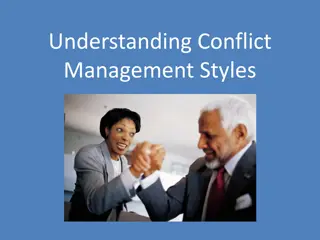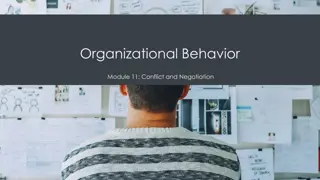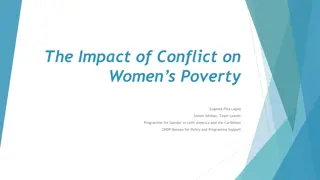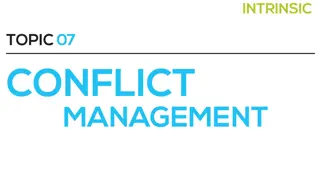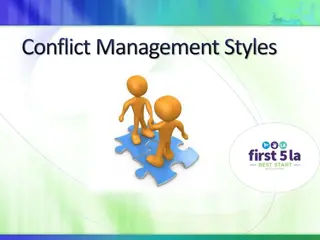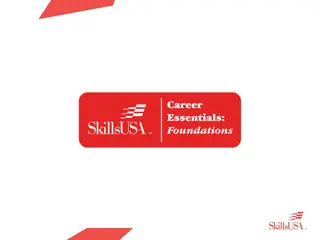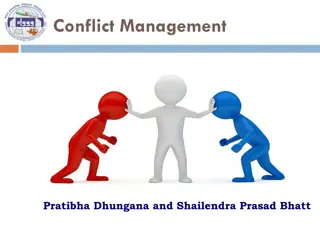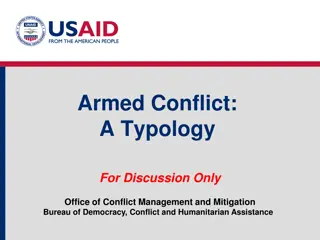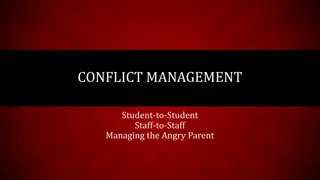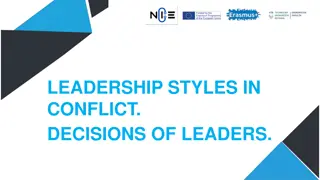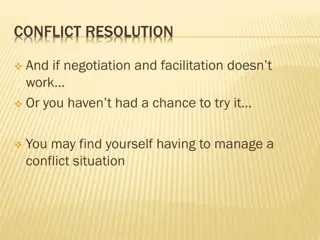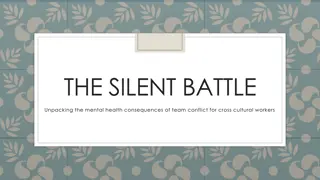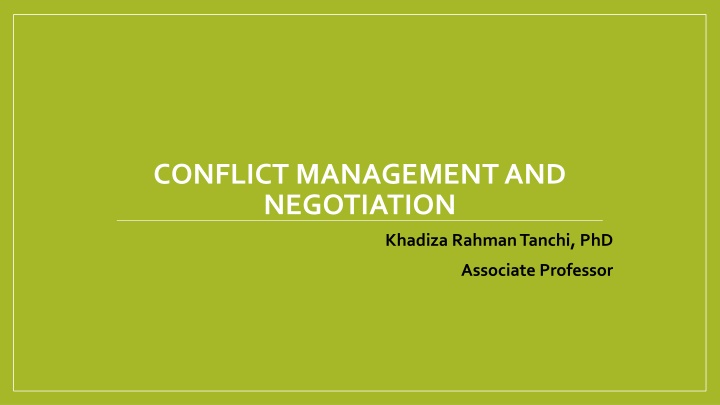
Effective Conflict Management and Negotiation Strategies Explained
Explore the concept, stages, types, and sources of conflict, along with conflict management strategies and the process of negotiation. Understand the nature of conflict, different levels and outcomes, from stimulating innovations to damaging relationships.
Download Presentation

Please find below an Image/Link to download the presentation.
The content on the website is provided AS IS for your information and personal use only. It may not be sold, licensed, or shared on other websites without obtaining consent from the author. If you encounter any issues during the download, it is possible that the publisher has removed the file from their server.
You are allowed to download the files provided on this website for personal or commercial use, subject to the condition that they are used lawfully. All files are the property of their respective owners.
The content on the website is provided AS IS for your information and personal use only. It may not be sold, licensed, or shared on other websites without obtaining consent from the author.
E N D
Presentation Transcript
CONFLICT MANAGEMENT AND NEGOTIATION Khadiza Rahman Tanchi, PhD Associate Professor
Topics to be Covered Concept of conflict Stages of conflict types and sources of conflict conflict management strategies grievance and conflict resolution process of Negotiation.
Definition and nature conflict? Definition: A battle, contest or opposing forces existing between primitive desires and moral, religious or ethical ideas (Webster s Dictionary) A state of incompatibility of ideas between two or more parties or individuals Conflict management is the practice of identifying and handling conflict in a sensible, fair and efficient manner Nature of Conflict: Negative Positive Innovative
Types and levels of Conflict Types of Conflict: Inter-personal and intra-personal Inter-group and intra-group Competitive and Disruptive Functional Conflict Dysfunctional Conflict Levels of Conflicts: Intrapersonal Conflict Interpersonal Conflict Intragroup Conflict Intergroup Conflict Conflict and competition
Outcomes of functional Conflict Conflict may stimulate innovations and creativity Organizational decision may be improved Alternative solutions to the problem may be found Conflict may lead you from strategic solution to common problems Individual and group performance may be enhanced Individual and group may be forced to reach for new approach Individuals and groups may be required to articulate and clarify the positions
Outcomes of dysfunctional Conflict Conflict may cause job stress and dissatisfaction Communication between individuals and groups may be reduced Aclimate of distrust and suspicious can be developed Relationship may be damaged Job performance may be reduced Resistance to change can be increased Organizational commitment and loyalty may be effected
How to create conflict? Not being a role model Take credit, no recognition Be judgmental Send written messages Subordinate should come to see me Make yourself inaccessible to your team Individual Vs. team approach Telling them? Consulting them? Or deciding with them? Come tomorrow Introduce change without consultation or discussion Poorly defined goals Divergent personal values Lack of cooperation/trust Competition of scarce resources Unclear roles/lack of job description
Methods to deal with conflicts Competition (win-lose situation) Accommodation (win-win situation) Avoidance (lose-lose situation) Compromise (lose-lose situation) Collaboration (win-win situation)
Steps to resolve conflicts Assure privacy Empathize than sympathize Listen actively Maintain equity Focus on issue, not on personality Avoid blame Identify key theme Re-state key theme frequently Encourage feedback Identify alternate solutions Give your positive feedback Agree on an action plan
1. Assure Privacy: In a workplace, if two employees have a disagreement, it's essential to assure privacy by choosing a neutral and private space to discuss the issue, ensuring that the conversation is not overheard by others. 2. Empathize than Sympathize: If a team member is expressing frustration about a project delay, empathizing involves acknowledging their feelings and understanding their perspective rather than simply sympathizing without fully comprehending the situation.
3. Listen Actively: During a conflict resolution discussion between a supervisor and an employee, active listening involves the supervisor paying full attention, making eye contact, and responding appropriately to the employee's concerns, demonstrating a genuine interest in understanding their point of view. 4. Maintain Equity: In a family setting, if there's a conflict between siblings, maintaining equity would involve ensuring that each sibling has an equal opportunity to express their grievances and that decisions are made fairly without favoring one over the other.
5. Focus on Issue, Not on Personality: If there's a disagreement in a project team, focusing on the issue means discussing specific concerns related to the project's timeline or approach rather than making personal judgments or criticisms about team members. 6. Avoid Blame: In a partnership, if there's a disagreement about financial decisions, avoiding blame involves discussing the financial challenges without assigning fault, enabling both parties to work together on finding a solution.
7. Identify Key Theme: In a community organization, if there's a conflict about resource allocation, identifying the key theme involves recognizing that the central issue is the fair distribution of resources to benefit all members. 8. Re-state Key Theme Frequently: During a conflict resolution meeting in a team, re-stating the key theme of the discussion (e.g., improving communication processes) multiple times helps keep the focus on the primary issue and prevents the conversation from straying into unrelated matters.
9. Encourage Feedback: In a customer service setting, encouraging feedback from dissatisfied customers involves actively seeking their opinions, listening to their concerns, and using the feedback to improve service quality. 10. Identify Alternate Solutions: In a business partnership, if there's a conflict over marketing strategies, identifying alternate solutions may involve brainstorming and considering various approaches that could meet both parties' marketing goals.
11. Give Your Positive Feedback: In a project team, if a conflict has been successfully resolved, giving positive feedback involves acknowledging the team's efforts in reaching a solution and expressing appreciation for their commitment to collaboration. 12. Agree on an Action Plan: After resolving a conflict between two team members, agreeing on an action plan involves outlining specific steps to be taken to address the root causes of the conflict and prevent similar issues in the future
How to prevent conflicts Frequent meeting of your team Allow your team to express openly Sharing objectives Having a clear and detailed job description Distributing task fairly Never criticize team members publicly Always be fair and just with your team Being a role model
Negotiation A negotiation is a strategic discussion that resolves an issue in a way that both parties find acceptable. In a negotiation, each party tries to persuade the other to agree with his or her point of view. By negotiating, all involved parties try to avoid arguing but agree to reach some form of compromise.
Negotiation Process Preparation and Planning 1. Definition of ground rules 2. Clarification and justification 3. Bargaining and problem solving 4. Closure and implementation 5.
Preparation and Planning This stage involves gathering information, setting objectives, and planning the negotiation strategy. It's crucial to understand the interests and priorities of all parties involved. Example: Before entering into a business partnership, a company may conduct market research, assess potential partners, and set clear goals for the negotiation, such as pricing terms, distribution channels, and marketing responsibilities.
Definition of ground rules Establishing ground rules helps create a framework for the negotiation, ensuring that all parties understand the process, expectations, and acceptable behaviors. Example: In labor negotiations, ground rules may include guidelines on meeting frequency, the format of discussions, and the use of third-party mediators, creating a structured and fair environment for the negotiation.
Clarification and justification During this stage, each party clarifies its positions, interests, and reasoning behind specific demands. It aims to foster understanding and provide a basis for further discussion. Example: In a negotiation between a software vendor and a client, the vendor may clarify the reasons behind the proposed pricing structure, emphasizing the value of advanced features and ongoing support
Bargaining and problem solving This is the core stage where parties exchange proposals, make concessions, and work together to find mutually acceptable solutions. Problem-solving is central to overcoming differences. Example: In a real estate negotiation, a buyer may offer a lower purchase price while the seller may counter with concessions such as including certain appliances. The parties engage in bargaining to find common ground.
Closure and implementation Once an agreement is reached, this stage involves formalizing the terms, documenting the agreement, and planning for its implementation. Example: After negotiating a contract for the supply of raw materials, the buyer and supplier finalize the agreement by documenting quantities, delivery schedules, and payment terms. They then proceed with implementing the terms outlined in the contract.


